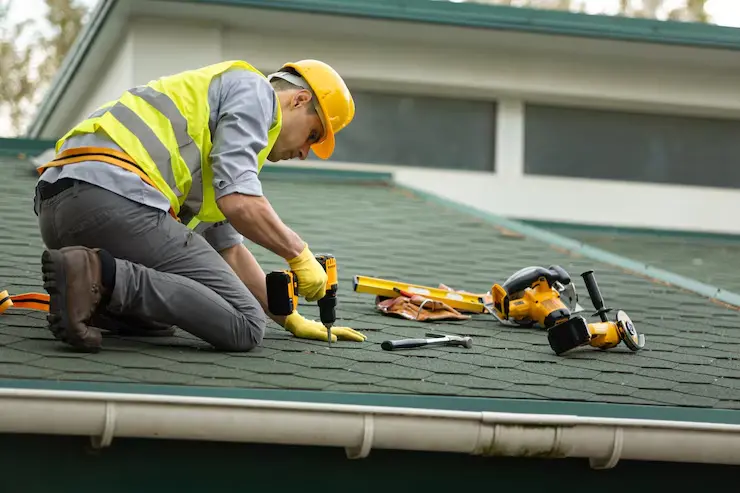Roofing Repair Los Angeles: Common Issues and How to Fix Them Safely
It doesn’t take a storm to ruin a roof in the city of Los Angeles. The weather here plays by its own rules. One week, it’s dry and running 95°F. The next day cold rain hits without warning. And somewhere in between, a tile slips, a corner lifts, a faint stain appears. You barely notice it until… You do see the roof having issues.
That’s usually when roofing repair Los Angeles becomes more than a Google search—it becomes urgent. Some people panic. Others wait it out, hoping it’s nothing serious. But roof damage rarely fixes itself. And delaying just adds cost, sometimes danger.
Why Small Problems Keep Growing
Most L.A. homes weren’t built with decades of extreme heat and shifting climate patterns in mind. The materials hold up—until they don’t. Over time, specific problems come back over and over again:
- Roof edges that curl or crack in the sun
- Tiles that slide out of place during a strong wind
- Flat roofs collect standing water near drains
- Dark streaks from algae or moss near vents
- Rust forming around roof joints or skylight bases
People don’t always know what’s happening up there. And honestly, most don’t want to. Who climbs their roof for fun?
It’s Just a Leak… Until It’s Not
A bit of dripping? Maybe. That slow drip turns into sagging drywall. Then mold. Then damage to whatever’s underneath—insulation, wiring, you name it.
What starts small gets expensive fast. Especially when it’s hidden for months before you even notice. Water doesn’t stay put. It travels. Quietly. So by the time you see the wet patch on your ceiling, the real damage has already spread somewhere else.
What Can You Catch From the Ground?
There’s a lot you can spot without risking your neck:
- Tiles missing or out of line
- Water marks beneath the eaves
- Discoloured streaks running down walls
- Signs of wood rot or blistered paint near the roofline
- Chimney flashing that looks bent or lifted
Sometimes even the attic gives away clues. Look for damp insulation, streaks along the wood, or visible sunlight in spots where there shouldn’t be any.
One Material Doesn’t Fit All
Here’s where some homeowners go wrong. They patch a clay tile roof with whatever they find at the hardware store. Maybe a leftover asphalt shingle or some makeshift cover. It holds for a while… until it doesn’t.
Different roofs need different repair materials. That isn’t just about looks—it’s about expansion, weight, and durability. Installing the wrong thing might do more harm than good. Always match materials. If yours isn’t available anymore, replacing just that one part might not be enough.
What’s Going on Around the Vents and Chimneys?
Often, the trouble isn’t the roof itself but what’s attached to it. Around chimneys, vents, and skylights—these are common failure points.
Over time, flashing can lift or corrode. Even a tiny gap here lets water in. It gets under the roofing layer and stays trapped, slowly seeping into the home. If repairs skip these areas or just slap on sealant without fixing the metal underneath, expect that leak to return.
Does Your Roof Breathe Properly?
People forget that roofs need to breathe. When they don’t, heat and moisture build up underneath. This warps the surface over time and shortens the roof’s lifespan.
You want your attic to stay dry and relatively cool, even in the middle of summer. That’s where roof ventilation matters. Proper air flow can cut cooling costs, prevent mould, and help keep shingles from curling due to excess heat buildup.
Good airflow isn’t something you see, but its effects are everywhere—longer roof life, better indoor comfort, fewer repairs.
DIY vs. Letting It Be
Some repairs look easy. You find a crack, press in some sealant, maybe re-nail a shingle. It holds—until the weather hits again. And now the water goes further, deeper, finding paths you didn’t seal.
Walking on an older roof can also break parts that were still intact. That’s the trade-off. Fixing one thing might create two new issues if you’re not careful.
Ask yourself:
- Are you sure where the water’s coming from?
- Do you know if there’s rot under the surface?
- Will your fix let the area drain as it should?
- Can it handle the next 90-degree day or sudden rain?
If not, stop. There’s no shame in pausing and asking someone who knows. Making things worse isn’t cheaper.
Permits Exist for a Reason
LA has rules. Even if it feels like no one’s watching, someone probably is. If you make structural changes or add certain materials, you may need city approval.
Repairs that don’t meet the California building code can become a problem when selling or refinancing your home. Inspections often uncover unpermitted work, which then requires redoing—legally.
Even if the damage looks simple, it’s smart to check local regulations before starting.
What You Should Expect From a Proper Repair
A solid roofing repair should cover:
- The right materials for your roof type
- Proof of what’s broken, and what’s been done
- Clean-up after the job (no nails or scrap left behind)
- A short explanation of what to watch going forward
- Optional inspection records, if available
If all you get is a handshake and a quick bill, that’s not enough.
Some Final Thoughts
You might not think about your roof until something drips. That’s just how it goes. But when it does, the most brilliant move isn’t to panic—or ignore it.
Fixing roof damage in Los Angeles isn’t just about sealing a leak. It’s about understanding why that leak started. What failed. What’s nearby that could fail next? And whether the fix will last through this season, or the next three.
Roofs aren’t permanent. But good repairs? They can buy you time. Years, even. And give you peace of mind every time it rains.
Also Read-How Much is 50 Ounces? 12 Most Common Things That Weigh About 50 Ounces

